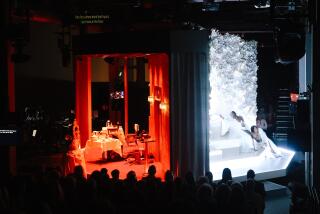BIZET OPERA ON TELEVISION : MET TRIES, IN VAIN, TO SALVAGE ITS ‘CARMEN’
The Metropolitan Opera hasn’t had much luck with “Carmen” lately.
Last year, the once-illustrious company mustered a lavish new version of Bizet’s not-so-hardy perennial. It was staged, with sleepy mock-realism, by Peter Hall and designed, with ponderous prettiness, by John Bury.
The title role fell--that is the right verb in this case--to Maria Ewing, a.k.a. Lady Hall. A thoughtful, eminently original singing actress, she succumbed to a case of heroic miscalculation and reduced the tempestuous heroine to a pouty little brat.
Most of the critics booed. So did some of the audience.
This year, the dauntless Met tried again. It discarded, or at least toned down, the silliest elements in Hall’s staging scheme. It kept Bury’s original sets but found new, flashier costumes for the titular Gypsy. It drafted a more glamorous cast. No use.
The 1987 model, which PBS will telecast tonight as part of the “Live From the Met” series, remains dull and plodding. Despite the extrovert conducting of James Levine, it still is a “Carmen” desperately in need of a central musico-dramatic focus. (It airs for three endless, intermissionless hours beginning at 8 on Channels 28, 50, 15 and 24.)
The new Carmen is Agnes Baltsa. The celebrated Greek mezzo-soprano would seem to command all the right prerequisites for the role: dark and sultry tone, a wide range that embraces a chesty snarl as well as ringing top notes, a bold and attractive stage presence, a good brain.
Better directed, within the context of a more sympathetic production, she might really capitalize on her resources. Here she seems to have been left pretty much to her own devices.
These include some generalized vamp gestures, some nasty brooding poses and some wildly comic leaps and lunges during the Habanera. If Ewing gave us Carmen as a fallen sparrow, Baltsa sketches Carmen as a crazed gazelle. The close-up cameras, moreover, are unkind to her.
She does spin out some long, imposing lines, does inflect the text with some interesting colors, does play on a formidable scale. Even these advantages are mitigated, however, by a tendency toward exaggeration, not to mention distortion of the French vowels.
Jose Carreras, her somewhat stilted, genuinely Hispanic Jose, looks properly young, handsome and vulnerable. He sounds marvelous, too, when he can float the sweet pianissimo phrases that define the violent hero’s tender emotions. Here, as in the more successful Salzburg performance under Herbert von Karajan, he even caps the Flower Song with an exquisitely whispered high B-flat.
His slender tenor all but breaks under the pressure of the great dramatic outbursts, however, and one worries about his future. That future, not incidentally, includes a grotesquely foolhardy Otello.
Leona Mitchell, who replaced the originally scheduled Gabriela Benackova, is a rather thick-sounding, husky Micaela. Samuel Ramey, the basso-oriented Escamillo, contents himself with the customary mock-macho bluster. The crucial comprimarios are nonentities.
Poor Bizet.
More to Read
The biggest entertainment stories
Get our big stories about Hollywood, film, television, music, arts, culture and more right in your inbox as soon as they publish.
You may occasionally receive promotional content from the Los Angeles Times.










